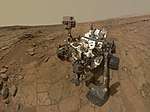Kepler-84
Kepler-84 is a Sun-like star 1118 light years (342 parsecs) from the Sun. Kepler-84 is a G-type star and a near solar twin. A speckle survey of G-dwarfs by Elliott P. Horch in 2002 noted that Kepler-84 may not be non-single star.[3]
| Observation data Epoch J2000 Equinox J2000 | |
|---|---|
| Constellation | Cygnus |
| Right ascension | 01h 37m 40.87964s[1] |
| Declination | +12° 04′ 42.1742″[1] |
| Characteristics | |
| Spectral type | G3[2] |
| Details | |
| Mass | 1[2] M☉ |
| Radius | 1.2 ± 0.2 R☉ |
| Temperature | 5755[3] K |
| Metallicity [Fe/H] | +0.09 ± 0.04[2] dex |
| Age | 4.9[4] Gyr |
| Other designations | |
Kepler-84 | |
| Database references | |
| SIMBAD | data |
| ARICNS | data |
Planetary system
Kepler-84 is orbited by five known planets, four small gas giants and a Super-Earth.[5]
References
- "Kepler-84". SIMBAD. Centre de données astronomiques de Strasbourg. Retrieved July 13, 2016.
- Vidotto, A. A; Gregory, S. G; Jardine, M; Donati, J. F; Petit, P; Morin, J; Folsom, C. P; Bouvier, J; Cameron, A. C; Hussain, G; Marsden, S; Waite, I. A; Fares, R; Jeffers, S; Do Nascimento, J. D (2014). "Stellar magnetism: Empirical trends with age and rotation" (PDF). Monthly Notices of the Royal Astronomical Society. 441 (3): 2361. arXiv:1404.2733. Bibcode:2014MNRAS.441.2361V. doi:10.1093/mnras/stu728.
- Gray, R. O; Corbally, C. J; Garrison, R. F; McFadden, M. T; Robinson, P. E (2003). "Contributions to the Nearby Stars (NStars) Project: Spectroscopy of Stars Earlier than M0 within 40 parsecs: The Northern Sample I". The Astronomical Journal. 126 (4): 2048. arXiv:astro-ph/0308182. Bibcode:2003AJ....126.2048G. doi:10.1086/378365.
- Melendez, Jorge; Dodds-Eden, Katie; Robles, Jose A (2006). "HD 98618: A Star Closely Resembling our Sun". The Astrophysical Journal. 641 (2): L133–L136. arXiv:astro-ph/0603219. Bibcode:2006ApJ...641L.133M. doi:10.1086/503898.
- openexoplanetcatalogue.com Kepler-84
This article is issued from Wikipedia. The text is licensed under Creative Commons - Attribution - Sharealike. Additional terms may apply for the media files.


